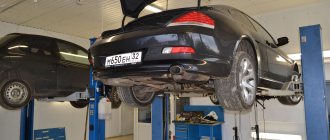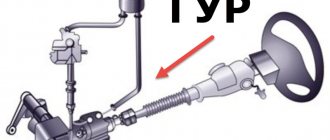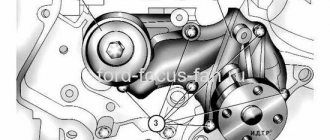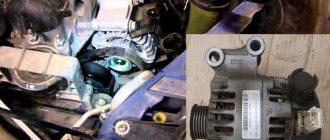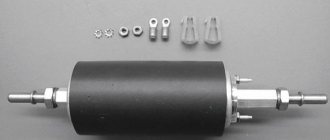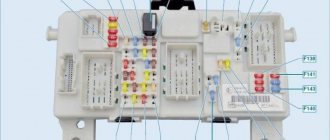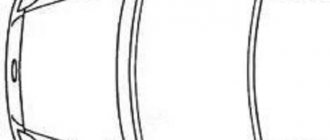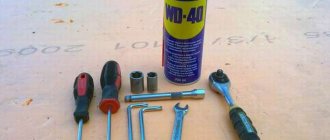How to check the steering rack on a Ford Focus 2: we analyze it in detail
The rack-and-pinion control mechanism, or simply the steering rack, sometimes fails, causing a lot of trouble for the car owner. Since its performance directly affects traffic safety, it is necessary to monitor the condition of this rather complex device with special care. This does not mean that you need to immediately change the entire assembly; in many cases it is possible and necessary to repair the rack or adjust it.
Principle of operation
The steering mechanism used in many modern cars is a rack and pinion system. The rack and pinion consists of several components, including universal joints, main and intermediate shafts, and at the center is the rack itself, or gearbox. It is this central unit that receives contact from the driver via the steering wheel and column and sends the desired signal through the mounting rods and shafts to ensure smooth and efficient turning left or right.
Important! However, from time to time, any rack or hydraulic booster will wear out. Prompt and efficient maintenance of this important component can make the difference between a minor inconvenience and a little wasted inspection time, or a major costly repair to the component.
The steering rack is essentially the heart of the vehicle's control system. When it completely wears out or breaks down, you have the potential to seriously limit how much control your car can handle. If a breakdown occurs while driving, it can be extremely dangerous. Therefore, by promptly paying attention to signs of rack wear, you can save money, time, and significantly reduce the likelihood of an accident.
Manifestation of malfunction
Here are a few symptoms or signs that may alert you to a potential steering problem while driving your vehicle.
Very tight (tight) movement of the steering wheel or, conversely, the presence of play. The steering system is supported by a power steering unit that uses hydraulic pressure to control the steering wheel easily and quickly. When it starts to rotate with great effort, or “bites” during rotation, one of the reasons may be a loss of hydraulic pressure.
Important! You should also be wary if play has appeared and the steering wheel has become too responsive to steering (possibly creating the illusion of unevenness on the road). In any case, this is a problem that will not go away on its own, the cause should be checked and corrected as soon as possible by a qualified professional. Perhaps the entire repair can be done by adding power steering fluid or minor adjustments to the mechanism, but these symptoms should not be left unattended.
Leaking power steering fluid. As noted above, sometimes rough steering is caused by low power steering fluid levels. However, since the steering is hydraulically actuated, fluid levels will not decrease unless there is a leak in the system. If the power steering fluid level is below normal or decreases significantly, this may mean that the steering rack boot is torn, the gasket is worn out, or another mechanical problem is causing a leak that must be corrected as soon as possible. Otherwise, excess friction will be created in the steering rack or power steering, potentially damaging the rack and other components, which can lead to an accident.
Power steering fluid leaks can be distinguished from other fluids by their smell (usually the smell of burnt oil). It is also typically the red or pink color that drips from the back of your engine. If you find this type of fluid under your vehicle, take it to a mechanic as soon as possible to have the leak checked and repaired before it causes further damage, requiring more serious Ford Focus 3 steering rack repairs. into the steering wheel."
When your steering rack is faulty, the noise is usually caused by a lack of proper lubrication and maintenance. Excessive friction in metal-to-metal contacts creates a loud noise when the wheels are turned at significant angles. You may hear this sound when turning sharply. If you notice an unusual sound when turning the steering wheel left or right, contact a mechanic to diagnose and timely repair the rack, if necessary.
Ford Focus 2 - problems with the steering wheel
Steering is one of the most important vehicle systems, on which driving safety directly depends. If the steering wheel of the Ford Focus II is difficult to turn or there are other problems, this significantly complicates the operation of the car. Among the most common problems is a malfunction of the power steering, which causes imbalances in the system, which can only be corrected through repair.
The nuances of car steering
The significant parts of this system are the drive and mechanism. In addition, the unit contains an electric or hydraulic amplifier, which makes the transmission of torque to the wheels a more comfortable process. Nowadays, all Focuses are equipped with this unit, including the second generation of the model.
This part may fail, which occurs as a result of loss of system tightness. There are a number of problems that cause damage to the power steering of a car, including play in the Ford Focus 2 steering wheel:
- Poor quality road surface;
- Neglect of the machine’s operating instructions, including failure to comply with maintenance schedules;
- Using low-grade lubricant;
- Frequent steering tension and illiterate use of the unit.
If there is a grinding noise when turning the steering wheel, the steering wheel tilts to the left, or the Ford Focus 2 steering wheel is completely jammed, you should start with a body geometry test. A power steering malfunction can be diagnosed by mistake, and the problem lies in the bending of the side member as a result of even a minor accident. It is important to keep all suspension and body parts in perfect working order.
Possible problems with the steering wheel
Regardless of the behavior of the car, the cause of problems with the steering wheel may lie in all sorts of problems - squeaking when turning the steering wheel, vibration or heavy turning of the steering wheel. In addition, very often the breakdown of the hydraulic booster is to blame. These problems greatly reduce vehicle controllability and driving safety. Although the power steering on the Focus has a long service life, improper use can damage the system element.
However, even if the hydraulic booster stops working, the car will be controlled, but you will feel a heavy steering wheel and more difficult control. If the Ford Focus 2 steering wheel does not turn, the reason lies in improper care of the car, which leads to depressurization of the unit, breaking the belt or weakening the tension.
Problems also occur as a result of breakdown of the hydraulic booster itself. This situation can be diagnosed by indirect and direct signs:
- There is a knocking and noise when turning the steering wheel. Extraneous sounds arise from the steering area in the cabin or are heard from the engine compartment, near the front wheels;
- A tight steering wheel or a significant increase in free play of the unit causes the steering wheel to hit when braking. In particularly difficult situations, the Ford Focus II steering wheel may completely lock;
- Incorrect functioning of the amplifier; when braking, the steering wheel vibrates and noises are heard in the power steering area;
- Damage to the power steering due to depressurization of the system.
How to determine whether a steering rack is faulty
The thing is that when you turn the steering wheel, the wheels, through this unit, accurately react to which direction they should turn. In some cars, the steering rack is installed without a power amplifier, that is, the mechanism is connected directly to the wheels, as a result of which it is necessary to apply quite a lot of effort to turn the steering wheel, especially when it comes to trucks.
Nowadays, most cars have amplifiers installed on the rack, which come in two types: - power steering - an amplifier that runs on liquid; — EUR is an amplifier that runs on electricity. Thanks to these devices, turning the steering wheel will be easier and more comfortable.
I would like to draw your attention to the fact that your safety primarily depends on this unit, since if it malfunctions, the maneuverability of the car is significantly reduced, which is especially important in city traffic. Also, the steering wheel can simply jam, which is why it is important that this system is always in working order.
Basic steering rack faults
Perhaps the main malfunctions of this mechanism include two:
- firstly, a knock on the steering rack, which can subsequently lead to the steering wheel jamming;
- secondly, a hum (pump hums) and fluid leakage.
By the way, if you have an EPS (electric power steering) on your car, then you need to know that such a device cannot leak, since there is no oil in its design, but it can knock very loudly.
Removing the power steering pump
We drain the working fluid from the power steering system (see “Removing and installing the steering mechanism”). On a car with Duratec 1.6i engine.
Using sliding pliers, we compress the ends of the clamp and slide it along the hose. Putting a rag.
. remove the fluid supply hose from the pump nozzle.
Use a 20mm wrench to loosen the tube fitting.
Using a 10mm socket, unscrew the pump mounting bolt, which also holds the tube mounting bracket, and.
. remove the bolt. Putting a rag.
. disconnect the tube from the pump.
Using a 10mm socket, unscrew the two pump mounting bolts and remove them from the holes.
Remove the power steering pump. Install the pump in reverse order. We fill the power steering system with liquid and remove air from it (see “Removing air from the power steering hydraulic drive”). On vehicles with Zetec-E 1.8i/2.0i engines, remove the accessory drive belt (see “Checking and replacing the accessory drive belt of Zetec-E 1.8i/2.0i engines”).
Disconnect the wire block from the pressure sensor.
Unclamping the clamp, remove the supply hose from the pump nozzle.
Using a 20mm wrench, unscrew the tube fitting and disconnect it from the pump. Using a socket or a 10mm wrench, unscrew the two lower mounting bolts.
. and two bolts for the top mounting of the pump. Remove the pump from the engine. Install the pump in reverse order. We fill the power steering system with working fluid and remove air from it (see “Removing air from the power steering hydraulic drive”).
What are the signs of a faulty steering rack?
The steering rack is a mechanism responsible for turning the front wheels of the car and connected to them through rods. Like any other unit, the element gradually wears out during operation, which negatively affects the controllability of the machine. Since this problem is related to the safety of the driver and passengers, the car owner needs to recognize the signs of a faulty steering rack in order to fix them as soon as possible or install a new spare part.
Symptoms of a Ford Focus 2 Steering Link Failure
One of the most common car problems is a faulty steering wheel. a device that connects the steering wheel and wheels and allows the driver to control them.
The point is that when you turn the steering wheel, the wheels passing through that area react precisely in the direction in which they are turning. In some vehicles, the truss strut is mounted without a reinforcement, i.e. the mechanism is connected directly to the wheels, which requires a lot of effort to turn the steering wheel, especially when it comes to trucks.
Most cars now have two types of amplifiers in the rail: - Power steering. liquid with amplifier; — EUR is an amplifier that runs on electricity. Thanks to these devices, turning the steering wheel has become easier and more convenient.
I would like to draw your attention to the fact that your safety primarily depends on this unit, since if it malfunctions, the vehicle’s maneuverability is significantly reduced, which is especially important in urban conditions. Also, the steering wheel can simply get stuck, so it is important that this system is always in working order.
Basic steering rack faults
There can be two main problems with this mechanism:
By the way, if you have a European car (power steering), then you need to know that such a device cannot leak, because there is no oil in its design, but it can knock very loudly.
Steering knock Therefore, knocking on this mechanism is a rather complex breakdown, which can be characterized by two types: superficial and internal.
The detonation surface may be due to the fact that when the traction bag breaks, the tip breaks quite quickly and begins to knock. To eliminate this damage, the tip and boots must be replaced with new ones. The process of replacing these parts is relatively simple if you know how and how to do it correctly.
An internal knock indicates a more serious problem with the inside of the steering rack, which is very difficult to determine on your own. The fact is that in the event of an internal failure, the internal pistons and steering bushings break or collapse, since they bear the main load.
This breakdown leads to knocking. By the way, one of the reasons for the noise during this breakdown may be a large output, which appeared over time due to high mileage.
Briefly about the mechanism
The element is a cylindrical body containing the following parts:
This is the design of a conventional mechanical and so-called electric rack, operating in conjunction with an electric power steering (EPS). If the car is equipped with a hydraulic booster (power steering), then the design of the mechanism is supplemented with cylinders and pistons that help move the gear bar in one direction or another.
The element works on a simple principle: when the steering wheel rotates, the drive shaft moves the rack through a gear in the required direction. The ends of the part connected to the rods cause the front wheels to turn. The power steering or electric power steering reacts to the movement of the steering wheel and “pushes” the rack and pinion mechanism in the desired direction, relieving physical stress from the driver.
Signs of trouble
Since most passenger cars are equipped with a hydraulic booster, symptoms of rack wear should be considered in conjunction with power steering elements - pump, control valve and oil lines.
Problems with the operation of the rack and pinion mechanism are divided into obvious and hidden. The motorist himself can identify the former while driving or as a result of inspecting components and assemblies. In the second case, the service station technician can clearly identify the fault. Your task is to react in time and contact a service station if the following symptoms appear:
Note. The specificity of the knocking of the rack and pinion mechanism is its central location, which makes it seem to the driver as if the sound is coming from both sides at once. A confirming sign is vibration on the steering wheel and an increase in play.
If you can clearly determine that the steering rack is knocking, perform an external inspection of the unit. Pay special attention to the rubber boots - they are visible through the arches of the front wheels and partially under the hood. The best option is an inspection in a viewing ditch. Gusts and oil on the accordions indicate that water and dirt have entered the element, accelerating the wear of all parts.
What to do with rack faults?
In the vast majority of cases, the steering rack is replaced or repaired at a car service center, since even removing the element is not an easy task. But minor problems can be solved on your own, for example:
The design of the rack provides for the adjustment of gaps in the transmission unit. In the early stages of gear wear, backlash is eliminated by tightening the adjusting screws. It is highly undesirable to perform the operation yourself: if you overdo it and leave no gaps, the gear train will wear out even faster.
When the problem lies inside the rack and pinion housing, you won’t be able to eliminate the knocking noise yourself, unless you are a car mechanic yourself. The most common internal faults are:
Some of the listed breakdowns are eliminated by installing repair kits in a car service center. It is better not to replace worn parts of the gear train separately - it is necessary to install a new rack.
Source
Signs of damage
I made an important conclusion for myself. The main killer of the steering rack, regardless of the car, is the road. It is the “excellent” quality roads in our country that lead to the need to buy a repair kit, spend time and money visiting service stations in Moscow, St. Petersburg and any other city. The worse the roads in your area, the more often you will encounter such phenomena as play, knocking and vibration.
If you have a car with hydraulic or electric power steering, you are in many ways lucky. They work well on high-quality imported machines. But their removal, replacement or repair is a task only for specialists.
Your mission is to detect faults in time. In the case of the steering rack, characteristic signs of failure are:
- the steering wheel becomes harder to turn in certain steering wheel positions;
- the RR knocks, a characteristic sound appears;
- the steering wheel vibrates;
- if this is a hydraulic hydraulic fracturing system, then hydraulic fluid begins to leak out;
- the steering wheel does not fully return to its original position after turning;
- When turning the steering wheel, the wheels do not turn in accordance with the rotation of the steering wheel.
If there are problems with the RR, there are two ways to solve the problem - replace the part with a new one or try to repair it. Find out how much repairs and parts cost, compare them with the prices that experts ask for. At many service stations, as I noticed, even if it is possible to get by with minor repairs, the technicians offer to change the rack. This is beneficial to them, since replacement costs more than minor repairs. Therefore, I advise you to find a trusted car service, where they will not deceive you, but will do what is really needed.
Although some people themselves know where the rack is in their car, which stores sell good used RR units and how they can be changed with their own hands. If there are domestic old cars, I support self-repair. For our newer cars and especially foreign cars, I strongly recommend not to repair the rack yourself. Too responsible job.
Ford Focus steering rack repair: symptoms and causes of failure
Issues discussed in the material:
Everyone knows that the steering rack on Ford Focus cars of the first, second and third generations often breaks. This happens due to the harmful effects of many factors on the mechanism. If you drive aggressively, and the road is not in perfect condition, the fastening mechanisms are not tightened enough, corrosion will appear on the inner sleeve, the seals and rubber bands will break.
As a result, repair of the Ford Focus steering rack is inevitable. Moreover, the design features of this device are such that the mechanism will have to be completely changed. You will learn how to carry out repair work correctly from our article today.
Reasons for failure of the Ford Focus steering rack
Have you thought about repairing the Ford Focus steering rack because knocking noises have appeared? First of all, you need to understand how it is structured. The steering gear housing on the Ford Focus is located under the hood of the car, while the rack is bolted to the front suspension. There is also a special device on the steering column that absorbs shock energy when you drive on a bad road surface. In addition, a steering wheel position adjustment system and an anti-theft ignition mechanism are installed, which is responsible for blocking the wheels while the car is turning.
The steering system kit for this car model includes a switch block. They ensure proper operation of headlights, turn signals, and windshield wipers. Such a complex and well-thought-out control system makes driving a vehicle as comfortable and safe as possible. Therefore, if you notice any problems, you should immediately diagnose the car and, if necessary, repair the Ford Focus steering rack.
The Ford Focus has the following symptoms that indicate a malfunction of this mechanism:
It is also necessary to remember that there are some signs that indicate that the adjusting bolt is not tightened enough, but the device does not need to be repaired.
You should not only know the symptoms of the malfunction, but also understand why the breakdown occurred. For example, if you notice knocking noises and the free play of the steering wheel has increased, this means that the thrust spring is not tensioned enough, or the ball joint or cardan joint is worn out, or the steering mechanism mounting bolts are not tightened properly.
Has the steering wheel become stiff and you have to exert a lot of force to turn it? This means that the power steering pump drive belt is slipping or has become unusable, air has entered the hydraulic system, the working fluid level is low, the hoses are torn or twisted. This symptom also occurs when the pump pressure is low or there are leaks in the pump or steering gear.
The reason that the steering wheel does not go to the center position may be that the stop spring is not tensioned enough, the internal hinges or tip hinges are difficult to turn.
We recommend
Tapping and noises indicate that the fastenings of the rods, steering gear, and ball ends of the rods are loose. Worn rods and ball joints can also cause this symptom.
No matter what kind of breakdown occurs, you should immediately go to a service center, where a technician will diagnose and perform the necessary repairs.
Features of car steering
The most important components of steering are the drive and mechanism. In addition, the unit contains a hydraulic or electric amplifier, which provides simpler and more convenient transmission of torque to the wheels. Today, this mechanism is installed on every Ford model.
Along with increasing comfort when driving a vehicle, the amplifier may fail, and a similar steering malfunction occurs when the entire structure loses its tightness. In this regard, it is extremely important to regularly keep this node under control.
There are some possible reasons why your car's power steering may be damaged:
- Bad roads, neglect of the advice of the automaker, including failure to comply with recommended maintenance periods, use of low-quality lubricant. Also, power steering problems occur due to regular voltage and improper operation of the system.
- Deterioration in driving dynamics can result from improper balancing of vehicle wheels, poor wheel alignment, failure of suspension elements, excessive damage to vehicle tires and lack of recommended tire pressure.
- It is important to test the body geometry. A breakdown of the hydraulic booster can be misdiagnosed, and even a minor accident that causes the spar to bend is to blame. The car owner may not even be aware of such a problem, shifting the troubles to the steering system of the car. That is, every part of the body and suspension must be in proper condition.
Ford Focus steering rack repair
If you have a Ford Focus 3, you can repair the steering rack and power steering with a simple set of tools, a jack, keys, and new parts. Most often, failure occurs due to the fact that the support bushings and teeth have become unusable. The device has such design features that due to the severe shocks experienced by the suspension while driving on a bad road surface, the steering mechanism becomes unusable. Repair consists of removing faulty elements or replacing them with new ones. In addition, you can buy and install reinforced parts, which have a much longer service life.
To repair the Ford Focus 2 steering rack with your own hands, you should purchase a repair kit, that is, oil seals for this car model. When repair work is being carried out for the first time, a nut will also be required. You will install it in place of the factory one, which is made of plastic. The nut is needed to tighten the device.
In order to polish the rod after repair, as well as remove small irregularities, you will need a lathe.
In addition, you will need a clamping fork, with its help you can eliminate the play in the engagement of the rack with the gear, as well as a spring that you install between the adjusting nut and the fork.
Power steering pump ford focus in Russia
Later, the generator mountings, both bolts and nuts, are removed. The connectors are disconnected. The expansion tank is also removed. Unscrew the pulley mounting bolts; there are four of them.
Remove the pulley. After unscrewing the top pin holding the generator, remove the generator itself. The connector is disconnected from the power steering pump.
The tube coming from the tank is removed. Remove the four bolts securing the pump. That's it, the pump can be removed. Everything is installed in reverse order. The liquid is immediately poured into the reservoir, the system is pumped, and the Ford Focus hydraulic pump is turned with the steering wheel in 2 different directions.
How to tighten the steering rack of a Ford Focus
Troubleshooting a Ford Focus does not always require repair or even replacement of the steering rack. Sometimes all problems are solved by tightening this device.
If you have a Ford Focus, you can easily repair the steering rack, especially if you have experience in such work. The main thing is to install the car on a lift to protect yourself, place stops under the wheels, remove the plastic motor protection, find the adjusting bolt, which is located on the rack, but getting to it will not be easy.
We recommend
You will see a plastic stopper on the bolt; it is installed at the factory. If it is there, it means that this mechanism has not been repaired on the Ford Focus before. We pry it off with a screwdriver and then pull it out.
It is made in the form of a plastic plug ring with small legs connected to grooves. When you remove a stopper that is made of a weak material, you don't have to worry about the nut or bolt being damaged.
Note! Since this part is tightly attached, you will most likely break it during removal. But don’t worry, because the bolt will not come loose, and the rail is reliably protected from dust.
The bolt should be tightened clockwise. How tight should I tighten it? It depends on what position it was in initially. It is best to tighten it slowly, a little at a time, monitoring the movement of the steering wheel, which should not be tight, as well as the knock in the rack. There is no need to tighten the bolt with sudden movements, because this can bite the rail.
Problems with steering, power steering / power steering
| Sequel (2021) |
| Power steering, electric steering, steering, steering rack, power steering fluid, steering tubes |
To suslik98 That is, I understood you correctly: it doesn’t matter what kind of oil to add or fill completely, the main thing is that it is red, as in my case? It turns out there is nothing wrong with the fact that the manufacturer filled in the original oil (red), and I added not the original but also red?
To VasAlex This is what needed to be proven =) The problem is airiness or lack of fluid, and they will come up with a big problem out of this and force you to shell out 10-20 rubles.
The photo shows a high-pressure power steering tube with liquid on it. Check the fittings on this tube, and check the second low-pressure tube; it often chafes and liquid leaks from it. First of all, I checked all the fluid levels. The power steering reservoir is located under the headlight.
What color is the liquid, is it hard to see in the photo?
Dmitriy.
The color is difficult to determine, a mixture with dirt. Looks like dark brown.
Is the electric power steering reservoir white and plastic?
This is EGR fluid, now we need to determine where it is leaking from.
If there is a leak from the longest tube (high pressure), then it needs to be changed; the leak most often occurs in the area of the fitting on the electric pump itself.
If the leak is from a short tube (low pressure), it can be repaired.
Best regards, Art. manager Dmitry.
Virgame To be honest, I wrote that in extreme positions the sound is very different from usual, at least that’s what I have with power steering on Rusff, my brother has power steering on ff se, and in general I’ve learned this on ALL cars with power steering while working in a car service center. Of course, in each case the situation may its own but it makes more noise in extreme positions - fact, good luck.
By the way, on 2.0 there should be an electric power steering and the sound is slightly different from the power steering.
The fluid for the electric power steering is green, I'll send you the tube number a little later.
You need to constantly monitor the level, otherwise you can lose the EGR.
Best regards, Dmitry.
Right? How can you tell if this liquid is green?
The EGR is filled with green!
Best regards, Dmitry.
If you don't check and the fluid goes away, you may end up replacing the pump.
And in terms of money, this is much more money.
We carried out a test drive on our premises, installed a new tube, turned the steering wheel all the way and started driving. After 5-6 laps, the tube could not withstand the pressure and began to leak in the area of the fitting.
On restyled focuses the situation is a little different. The tubes on them are slightly longer, so they lasted an average of 10 to 15 laps.
Best regards, Dmitry.
Raise and support the vehicle until the wheels are clear of the floor. For more information, refer to the chapter: (100-02 Using the jack and lifting the vehicle) Using the jack (Description and operation), Raising the vehicle (Description and operation). NOTE: Do not start the engine at this stage.
NOTE: Make sure that the fluid level in the power steering reservoir does not fall below about air will be able to enter the system.
NOTE:Bleeding the power steering system will reduce the vacuum. Using special tools, maintain a sufficient vacuum of 38 cmHg. pillar If within 5 minutes the vacuum decreases by more than 5 cm Hg. column, the system should be checked for leaks.
Features of repair of the Ford Focus steering rack of 1st, 2nd and 3rd generations
Structurally, the steering rack on the Ford Focus of the first, second and third generations is made the same, but differences can be found. For example, this mechanism on the 1st generation of cars breaks down quite rarely; the cause of the breakdown is usually improper operation of the car. For example, when the boot has become unusable, and the driver continues to drive the car. In addition, some cars were equipped with TRW parts at the factory, which are considered more reliable, while others were fitted with Ford parts.
Repair of the Ford Focus 2 2.0 steering rack may be required due to problems with the cracker, but the cause of the breakdown may be that the cylinder housing is worn out. In this situation, the rack shaft piston will be to blame if it is located in the middle position. When this element is worn out, the steering wheel will bite in the middle position. This can also happen after repairs using piston rings that do not fit.
The material from which the ring is made also plays an important role. After all, some alloys can wear away aluminum in a short time.
On the third generation of cars, hydraulics or an electric rack are installed. Repair of the Ford Focus power steering steering rack is carried out in exactly the same way as on a second generation car. Due to the fact that the bushings are of poor quality, repairing the electric steering rack on a Ford Focus will not be easy.
Comments from car enthusiasts about the repair of the Ford Focus steering rack
1. Tightening the steering rack adjusting nut: proceed carefully
“I bought a car and had no complaints. But when I turned the wheel completely, I heard tapping sounds on the right, especially when driving on a bad road. Why the extraneous sounds appeared was never determined. After 10 months, I read the advice of a car mechanic on a forum, where car owners described exactly the same problems as on my car. It was written there that such sounds cannot be ignored, because the device may fail. The mechanic advised me to tighten the adjusting nut. I will quote his words verbatim:
2. Does replacing the adjusting nut prolong the life of the steering rack?
“I always advise you to inspect the adjusting nut after 100,000 km. First, you should replace the plastic nut with a product from the first generation Ford Focus (American). Then we sharpen the edges of the piston and fill it with molybdenum grease between the worm and the shaft. If you have driven more than 160,000 km and there are knocks on the right, it means the Teflon bushing has worn out. It also needs to be replaced. There are no extraneous sounds on my car after 240,000 km, the main thing is to service it on time.”
3. “Gentle” diagnostics of the Ford Focus steering rack = its long service life
“In order not to repair the Ford Focus 2 1.6 steering rack, you should diagnose it correctly. Never sharply twist the steering wheel when the car is not warmed up. Otherwise, the seals will deteriorate; in the best case, they will simply be replaced, and the hydraulic booster will not have to be repaired. “When it’s cold,” turn the steering wheel as carefully as possible, rock it gently, this way you will warm up these elements. There is also no need to press the brake pedal sharply. Perform all actions slowly and carefully.”

